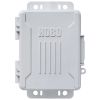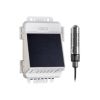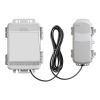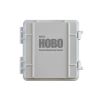HOBO MicroRX Station
Features
- Robust, weatherproof IP66/NEMA 4X enclosure
- Inputs for up to five plug-and-play sensors
- Built-in LCD confirms proper setup and operation
- Free ground shipping
- Expedited repair and warranty service
- Lifetime technical support
- More
Overview
The compact and rugged Onset HOBO MicroRX Station is an easy-to-deploy, low-cost cellular solution for long-term, reliable field monitoring. Two power source options are available: a solar panel for extended deployments, and user-replaceable batteries for flexible mounting in covered or protected locations. The station includes inputs for up to five of Onset's research-grade plug-and-play sensors. Configurable station-side alarms trigger immediate notifications of critical conditions, and Onset's cloud-based HOBOlink platform makes it easy to view, access, and share data.
Real-Time Data
Logged data from the station is transferred at regular connection intervals to HOBOlink® web-based software allowing access to the latest conditions, view graphs, configure sensors and alarms, set up a dashboard, download data, or schedule data delivery via email or FTP.
- HOBO RX2100 MicroRX Station
- Grease packet
- Cable ties
- Screws and washers
- Six AA lithium batteries (RX2101 battery-powered stations)
- Battery pack (RX2102 solar-powered stations)
In The News
Spring 2025 Environmental Monitor Available Now
In the Spring 2025 edition of the Environmental Monitor, we highlight partnerships across the world and the importance of collaboration between government agencies, universities, environmental groups, local communities, and other stakeholders. From great white shark research in Cape Cod to monitoring fisheries in Lake Erie, this latest edition underscores partnerships that connect stakeholders in a watershed through environmental data. With an emphasis on data sharing, a combination of real-time and discrete sampling keeps the public and partners informed of environmental conditions. Our writers also sought out science professionals dedicated to working with peers within and outside of the environmental sector.
Read MoreMonitoring Mariculture in the Gulf of Alaska
The mariculture industry in the Gulf of Alaska has been steadily growing in recent years, guided by ongoing research to help refine farm location and cultivation practices. A subset of aquaculture, mariculture focuses on rearing organisms in the open ocean. In Alaska, finfish farming is illegal, so most farms cultivate kelp, oysters, or a combination of the two. These small, locally operated farms started popping up in the Gulf of Alaska in the early 1990s, when shellfish farming first became legal. Kelp farming did not begin to catch on in the state until 2016. Many of the coastal areas that have grown interested in mariculture are historically commercial fishing communities.
Read MoreSupplying Seattle’s Drinking Water: Using Data Buoys to Monitor the Cedar River Municipal Watershed
Providing clean, safe, and reliable drinking water for the 1.6 million people in the greater Seattle area is a top priority for Seattle Public Utilities (SPU). With limited water supplies, SPU dedicates considerable resources to maintain its watersheds and mountain reservoirs. About 70 percent of Seattle Water comes from the Cedar River Municipal Watershed , and the other 30 percent comes from the South Fork Tolt River Watershed . [caption id="attachment_39574" align="alignnone" width="940"] Data buoy in Chester Morse Lake . (Credit: Kevin Johnson / Seattle Public Utilities) [/caption] Jamie Thompson, a fisheries biologist at SPU, monitors aquatic ecosystems centered on fish listed under the U.S. Endangered Species Act (ESA).
Read More




















































